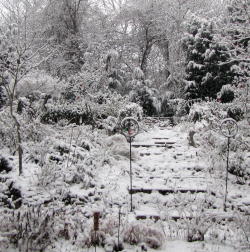
It has taken a lifetime of gardening for a certain truth to make itself evident.

Up until the last couple of years, when gazing lovingly upon the garden but with a critical eye about what might be needed to make it look better, the answer has usually been to buy more plants, new kinds of plants.
Limited by what was available for purchase at the time, or biting the knuckle and ordering online such as the Verbascum chaixii ‘Album’ ordered from Annie’s Annuals, it was always the hunt for plants that were not already growing here. Seen in a magazine article, blog post or in real life garden visiting, it was the wanting of what we did not have that seemed to be the cure for the dull garden blues.

Following that course for over thirteen years at this location along with bringing in favorites from previous abodes in several states and climactic conditions, there is now a nearly encyclopedic array of botanical delights growing in the Fairegarden. Many have died, oh so very many, but some have proven themselves to be flexible when it comes to wet or dry, sun or shade, even acidic or alkaline. Or being moved over and over and over again.
I am a true believer in the Piet Oudolf/Noel Kingsbury school of garden thought. Naturalistic plantings with a matrix of grasses, swaths of perennials that might stretch past the boundaries of the original plan and dottings of taller, more colorful volunteers is the longed for look. Pre-Piet, the method was more of a plop a plant where there was room for it. We are still working on not plopping. It is a journey, not a destination.

Achieving the garden design goal without creating budgetary night terrors calls for using those plants that have already proven themselves on our steep slope. Divisions and seed saving are the way. Cuttings have not been as successful but do work for some, such as Sedums. A story was written in 2009, click here to read it, about how there came to be so many plants growing here. Hint, they were not all purchased, as some folks mistakenly thought.

As rains return in the fall the soil becomes moist again and digging is easier. August is the time to make those divisions if weather permits in our USDA Zone 7a garden, allowing the roots to be settled in before winter arrives. My To Do list includes the spreading of various Stachys ssp. along the wall behind the main house to spots where the fancy Euphorbias have died out. Stachys seems to like it there.

Rudbeckia seedlings will be lifted from the gravel paths and placed where a burst of yellow in late summer would be welcome. Low grasses such as Festuca Glauca or Japanese blood grass, Imperata cylindrica rubra make great fillers and can be safely moved and divided if well watered now.

There is one spot that has been properly planted in the mass grass method, the stand of pink muhly, Muhlenbergia capillaris along the driveway, seen above in a shot featured in this post from October, 2010. If only we could get a similar vibe going in the rest of the garden using the divide and conquer scheme applied to the muhly border.
Does this mean there will be no more plant buying? Well, the answer would have to be no, because I am not just a gardener but also a plant collector. Trying new things is good for us, after all and I like to support local and some online businesses. But the solution to making the garden more appealing is far less expensive. Use what is on hand that has proven itself to be worthy.
Frances













I have been eyeing my neglected garden (due to my day job) and have come to the conclusion recently that i am taking stock of what works and what has earned the right to stay and will be dividing and moving a lot next year. Of course there is always more plant buying but now with a more discerning eye.
Oh yes, the divide to conquer is a frequent method here too. I don’t have many grasses in my garden though. I love the blood grass but can’t seem to find a place here that it likes.
Boohoo about the fancy euphorbias due to this summers generous amounts of rain…mine, too, are waving the rotted flag of defeat. However, if that is the trade off for not being a slave to constant hose, I’ll take it. That pictured variety of Verbascum is delightful and seems like it would be a wonderful companion for so many other plants. What is its bloom time and how long is it in flower? Love the looks of the ‘Harvest Moon’ echinacea. I bought about 5 echinacea ‘Cheyenne Spirit’ this spring and have been delighted with its color blend.
“Using what works “is such a smart way to garden. It’s why I let the Susans and native ex-asters grow with abandon. They can cover the shallow soil where nothing else wants to grow and that’s a good thing. I must take a page from the Piet Oudolf/Noel Kingsbury school of garden thought and add more grasses to my mix. I might have to visit a few nurseries this week! If the rain keeps up I can plant anytime! Your garden looks wonderful~in all the seasons! Love the eryngiums and echinaceas together. xoxoxogail
What good advice! It seems a no brainer to use what works, but the lure of new plants is always so tempting. I’ve been trying to follow the advice you gave. This year I’m aiming for bigger blocks of plants that really carry the garden all year…. basically the stuff that works…it’s been helping to make my plant collection look more “landscaped”. Yours looks great whatever method you’re relying on!
I wish the Stipa was reliably hardy for me 😦
Every season has its challenges but those tried and true plants, which vary in each individual garden, thrive no matter what it seems. Sorry about your disappointments but celebrating the success of certain plants (I so envy that pond of muhly grass) with division is sweet success indeed.
Your blog is not only one of the most beautiful, it is also the most charmingly instructive. I do plan to shop in my garden this fall, and see what divisions I can donate in the spring to the Bridge of Flowers plant sale. Unfortunately there is no pink muhly grass, to keep or share, in my zone 5 garden.
I struggle at gardening and really appreciate all you share! Do you know of a zone 5 garden blogger that I might subscribe to? I have been buying plants, but want my gardens to look more like yours, so I’m going to work on your advise and start sharing/dividing, etc. Thank you!
I have these same thoughts. I decided to try and start most of the really unusual from seeds. Some things worked. Others didn’t. I also divide a lot of things now and move seedlings about. The Earth doesn’t know a plant is precious or rare. Only humans do.~~Dee
Oh so true – and so difficult to learn! 😉 (And as usual, luscious photos to drool over!)
I totally agree with you. Your garden is always a beauty to me. I so enjoy your blog.
Love your last question…does this mean no more plant buying….hahahahaha. That Verbascum from Annie’s is gorgeous. I have to go out back and cut out a lot of dead from the excess water earlier this summer. ugh.
I’m a plant plopper, but I’m learning to appreciate the easy going perennials that love my little shady place in the world. The birds bring gifts too. I’ve developed a new garden rule: If it is a surprise gift, it gets to stay. Funny how that works, because eventually everything looks harmonious in spite of my poor planning! Loved this article.
It is hard to control the plant collecting tendencies! I find myself buying plants that I know won’t work for long, but I just have this urge to watch them grow for a while – see how they bloom – before passing them along to other gardeners. I guess I can call it ‘annual gardening with perennials’, LOL. Everything is looking lovely, by the way!
What beautiful gardens!!! I, too, ‘experiment’ a lot. If it works, great! If it doesn’t, try something else! I’m adhere to the saying, “if life gives you lemons, make lemonade’. I don’t fret when a plant doesn’t do as I want – I just try to find a place it wants! Love the muhley grass border!!!
Jacobs Ladder is a plant I’ve try for years (I love the color) to get established = with no luck (in Zone 8) !!!! I just ordered more to put out this fall. Does anyone have any suggestions as to how I can keep them alive and well?
I absolutely love your philosophy! And your garden . . .good grief, even though I share your philosophy, my garden looks nothing like that. Wish I could frame each of those pictures!
I witnessed this in your garden firsthand and have taken the lesson to heart, as much as I can when starting a new garden. I know what worked in the old garden which was not that much different in its beginning. If something here is doing well I ask myself where else could it do well, or even better than where it is.
Marvelous colours ! Especially I fell in love with the one with Yellowish Echinae, Fectuca glauca and Nigella. Maybe I some day will try Imperata cylilndrica, thoug it’s not here absolutely tough – but surely is worth trying !
Great advice, Frances: use more of what already works. Massing looks better anyway, plus using divisions saves money. Win-win!
I’m on a similar journey, but it sure is a long one!